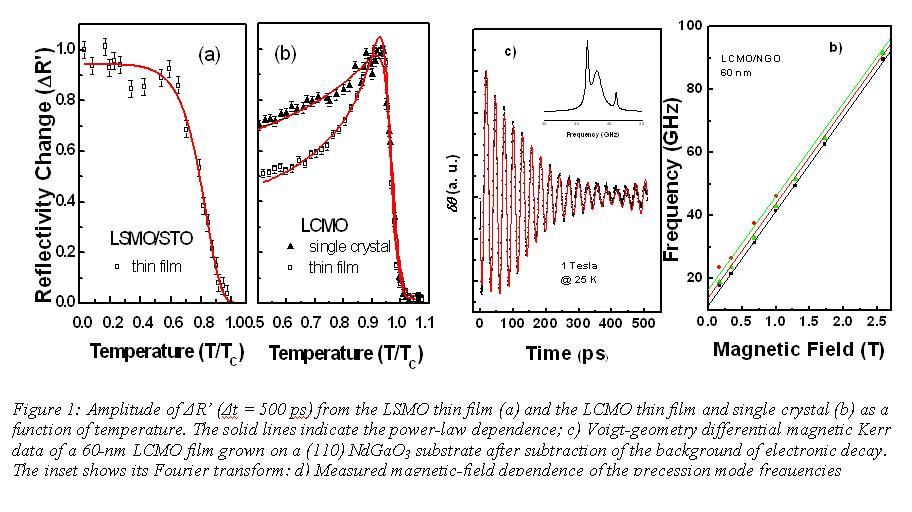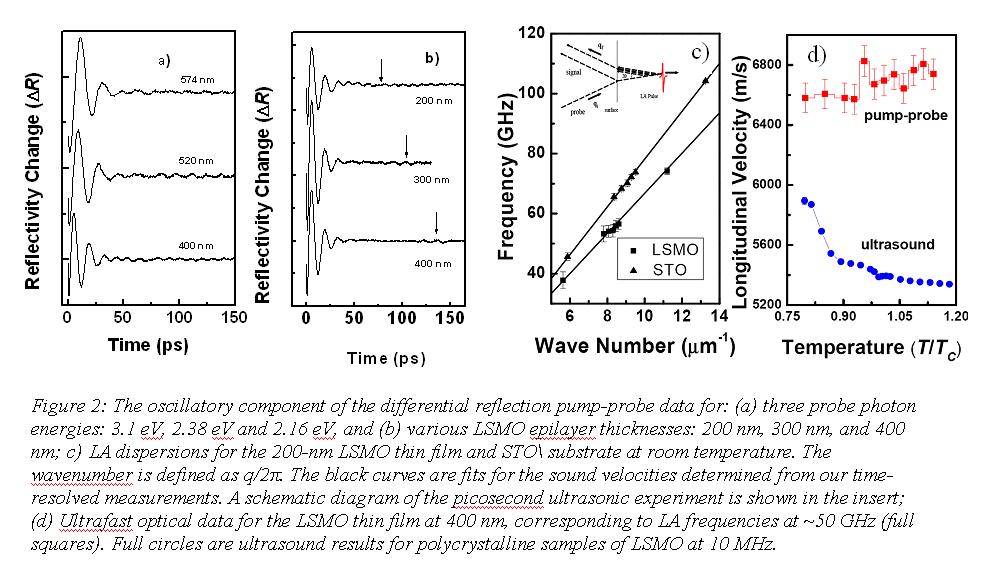
ACS PRF | ACS
All e-Annual Reports

45001-G5
Ultrafast Time-Resolved Optical Studies of Colossal Magneto-Resistance Materials
Femtosecond time-resolved optical and magneto-optical Kerr studies of coherent spin dynamics in La0.67Ca0.33MnO3: We have performed transient reflectitivity and magneto-optical Kerr measurements from the colossal magnetoresistance compound, La0.67Ca0.33MnO3 (LCMO) as a function of temperature and magnetic field. An unusually slow (~ µs) carrier relaxation component is revealed in the transient reflectivity traces. The component disappears as the Curie temperature is approached from below and shows no dependence of the metal-insulator phase transition. This slow decay process is attributed to spin-lattice relaxation of carriers in localized states (Fig. 1 (a) and (b)). In addition to the long spin-lattice relaxation process, we have also investigated the magnetic inhomogeneity by spin wave excitations. We generated and detected coherent magentization precessions by subpicosecond laser pulses (Fig. 1 (c) and (d)). The intrinsic inhomogeneities induce an effective confinement of the magnetic volume in the LCMO thin films. The confined spin waves are excited and detected in addition to the fundamental mode due to non-uniform optical excitation in depth. This allows us to estimate both the effective nearest-neighbor Heisenberg interaction (spin stiffness) and the effective magnetic correlations in the presence of a random spatial distribution of clusters based on a comprehensive model of the magnetic eigenmodes and their coupling to light.
Generation and detection of coherent longitudinal acoustic phonons in the La0.67Sr0.33MnO3 films by femtosecond light pulses: We have measured coherent longitudinal acoustic phonons by laser picosecond acoustics on the thin films of doped manganite La0.67Sr0.33MnO3 (LSMO) grown on SrTiO3 [100] (STO) substrate. The LSMO samples undergo a paramagnetic-ferromagnetic transition at a temperature TC =380 K. The ferromagnetic coupling between the nearest neighbor Mn ions results from a double-exchange mechanism. Although magnetoresistance in LSMO is not as high as in lower-bandwidth manganites, the Curie temperature in LSMO films can be tuned to the room temperature range. This makes LSMO a promising candidate for applications that use its magnetoresistance or the steep temperature dependence of resistivity near the Curie temperature. In this study, we employed a time-resolved two-color pump-probe setup to record the photoinduced reflectance oscillations due to excitations of longitudinal acoustic phonons. We determined the longitudinal sound velocities (elastic constants) of both the LSMO thin film and the STO substrate by changing the sample thickness and probe wavelength. We found that the values of the longitudinal sound velocity of LSMO at ~ 1010 Hz, in the zero-sound regime, are more than 20% larger than those from ultrasound experiments at 103 - 106 Hz. These results reveal the possible interaction of sound with charge-ordered clusters in LSMO for a temperature near or above TC.
Angular dependence of spin-wave resonance and relaxation in half-metallic Sr2FeMoO6 films: We investigated magnetic anisotropic parameters and spin-wave relaxation of thin films of the ferromagnetic half-metallic Sr2FeMoO6 by ferromagnetic resonance technique. The resonance field and linewidth were recorded as a function of relative angle between applied magnetic field and crystallographic axes of the sample. The resonance field varies sinusoidally and considerable line width broadening occurs when the applied field is rotated parallel to the sample plane. The results are described using higher order components of anisotropy fields. We obtain the values of the cubic anisotropic field, 2K4ll/M=0.09611 T, the effective demagnetization field, 4πM- 
